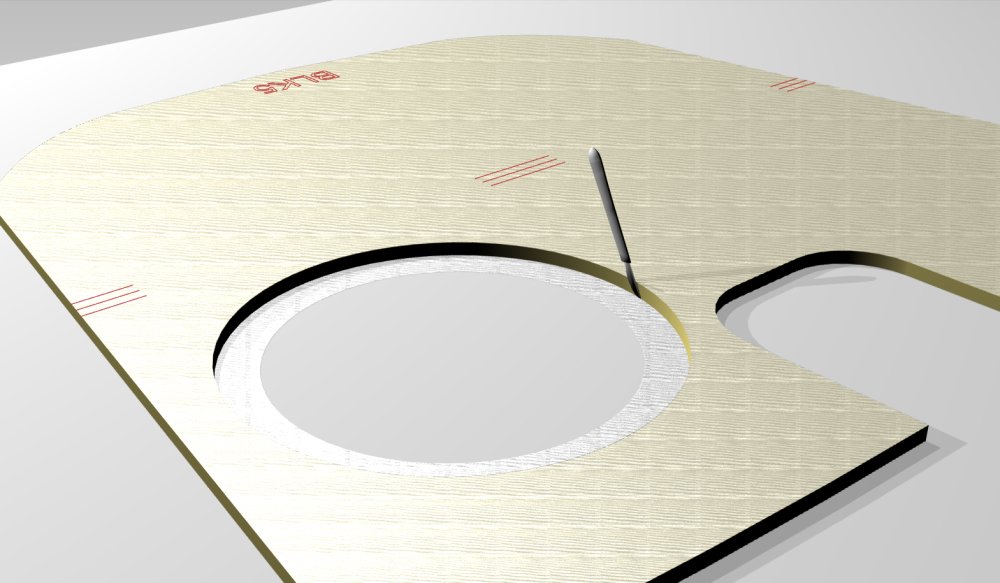Pre-Laminating the Foam Panels
Pre-laminating the foam panels before construction of the boat will save you a lot of time and help you make a stronger/lighter boat. I highly recommend doing as much of this pre-glassing upfront so that all the pieces you need in later steps are ready to go. A couple things to remember is that you want these panels to be as flat as possible. One insurance that you can make is to recheck the flatness of your flat table from time to time. Another detail to insure the panels stay flat is to store them on a flat surface after they are laminated. The epoxy will take 3-5 days to get to its final cure, and before this time, it will be in a green stage. In the green stage the epoxy is slightly rubbery, has a hint of stickiness, and the shape is not locked into the panel yet. For example, if you laminated a panel one night, pulled it off the flat table the next morning when it has setup, and then draped it over some boxes in the corner— you may be unpleasantly surprised to find that the panel has been locked into a S-curve. So find a nice flat place to unload and stack all your completed panels. Also, you may want to lay some plastic in between the greenest sheets to keep them from sticking to each other if you are not using peel ply.
Click Here for PDF of Laminate Schedule
“WETTING OUT” 8.8 oz FIBERGLASS CLOTH WITH EPOXY ON YOUR FLAT TABLE
Laminating 8.8 oz fiberglass onto bare foam is a bit different animal than laminating 6 oz. glass onto plywood. One thing that it helps to remember is that the foam surface is full of open cells that will fill up with resin. This is very important in the final bond of the fiberglass to the foam, and as such, care should be taken to insure a good “core bond”. I WOULD NOT recommend trying to lay dry cloth over bare foam and wetting it out from the top. The foam is so thirsty that you will battle to get the cloth to wet out properly and may waste a lot of time with poor results. Instead, apply all the epoxy need onto the foam first, and then lay the dry cloth onto that. This insures that all the open cells in the surface of the foam are full of resin and that you have a bomber bond to the core… you will also find that it goes very quickly with this method.
Laminating the First Panel Make sure your flat table is clean and has a fresh coat of wax on it. Start with a small panel first so you can get the hang of laminating the foam and work your way up to the large hull panels. In subsequent steps, it can save a lot of time to nest multiple panels and laminate them all at the same time.
Prepare a short nap roller, a clean squeegee, some sharp scissors, and paper towels. It is important to do all the prep BEFORE you mix up the epoxy because you have a short window to laminate the glass before the epoxy starts to thicken. Mix up the amount of epoxy needed for your panel and apply it in an even coat with your short nap roller (or squeegee). Be careful not to get drips of epoxy down the edge of your foam because it will cost you much time to sand off later. Now carefully lay down the dry fiberglass on your panel. It can help to pre-cut the fiberglass and roll it onto a cardboard tube so that you can unroll it without wrinkles. Now take your clean squeeqee and flatten out all the cloth till it is transparent and perfectly wet out. The glass should have a slight sheen to it when fully saturated. If you see any dry spots, apply a bit more epoxy to those spots with your roller or squeegee. Sight along the panel and carefully flatten any high spots with your squeegee. There should not be any puddles or dull spots…just a consistent even gloss on the surface of the transparent glass.

Once the epoxy is cured (12-24 hours depending of epoxy and shop temperature), come back with a razor knife and carefully trim the excess fiberglass from the edges. Be careful not to damage the edge of the foam in that it is precisely CNC cut and the edge shape is what determines the shape of your finished boat.



Post your comment on this topic.
Primary Author wrote: Jul 25, 2023
Foam core can have small pin holes, from time to time, that can allow a bit of epoxy to run through to the table side. This can become more of a problem in warmer weather as the heat will reduce the viscosity of the resin and allow it to flow through more easily. Laminating your panels when the shop temperature is 65 - 70 deg F will help minimize this. Also, make sure your table is well waxed (recommend Part All Paste Wax) and be sure to carefully pull the panel from the table as it is possible to damage the panel at this stage. Any blobs of epoxy should be carefully sanded down flush using a hard sanding block to assure a flat surface before adding more laminate.
Kurt Gauss wrote: Jul 25, 2023
I'm experiencing epoxy leaking through the foam lamination layers resulting in puddles on the table side of the panel. This is causing some headaches in trying to remove them without damaging the naked foam. If I don't remove then then I get a high spot at the puddle when I laminate the other side. Would a slurry reduce this? I'm using System3 slow cure.
Todd Bryan wrote: May 12, 2019
Having now laminated almost all the interior and deck panels for my boat, I cannot stress enough what a master class in foam core lamination Brandon's writeup and video are. Every sentence here, and every second of the video, is important to duplicate.
It took me many panels to recognize just how much epoxy I needed to roll onto the panel before placing cloth. You need to get that panel wet. There needs to be a thin, glossy, wet layer of epoxy all over the foam. If you do this successfully, the fabric wets out beautifully from below and only minor touchup with the squeegee is required. This technique is also quite fast. If you need to squeegee out a lot of epoxy on top of the cloth, it slows you down a lot. The panels he shows in the video would have taken me an hour when I first started out. I'm not down to 10 minutes per panel yet, but I'm getting faster.
I'm using System Three Silvertip with mostly slow hardener, as shown in the video. It's been awesome.
Brandon's calculated numbers for ounces of epoxy required are pretty dang close. Occasionally I've had surplus or needed to mix a small follow-up batch, but I always start with the numbers on the lamination schedule.
One small detail: in a few seconds of the video, Brandon uses a foam roller on a small section of cloth that needs extra epoxy. If you watch closely you can see the roller lift and wrinkle the cloth slightly. I get the exact same effect so I almost never use the roller on top of cloth - just the squeegee.
Brandon Davis wrote: Oct 17, 2018
The micro slurry is another way of doing these panels and can save a tad bit of weight (every bit adds up). One thing to note is that adding microballons in this step can cause some issues if the builder is not truly attentive. One issue I have seen with this method is mixing the fill coat too thick or applying it too thick which will then causes lumps under the fabric that are very hard to squeegee out. This will add a bunch of greif when fairing out the boat. Another problem is that the fill coat will hide the scribe lines and make it more difficult to assemble the boat.
Todd Bryan wrote: Oct 17, 2018
The Rutan manual outlines the use of "micro-slurry" to prep the foam core. It's largely the same technique as shown on this page, except that the epoxy that goes on the foam panel is mixed 1:1 by volume with glass microspheres (NOT phenolic microballoons). This reduces weight by making a fixed volume of epoxy go farther on a single foam panel. It costs time, though. I have found, however, that the foam consumes about the same amount of neat epoxy as a single layer of cloth, so it is a lot of weight over the entirety of the boat.